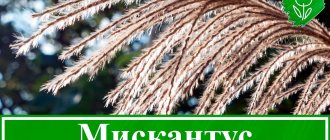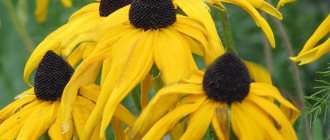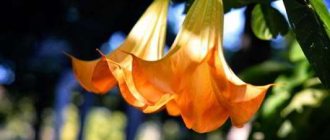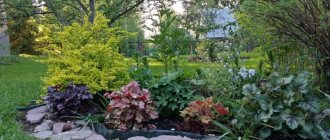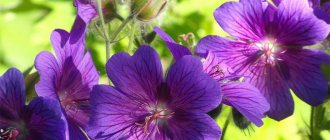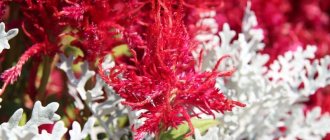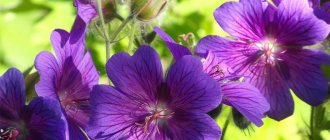If you're looking for an ornamental plant that can be grown near bodies of water or in damp areas, loosestrife is worth considering. Although the species is associated mainly with wet meadows, lake shores or forest clearings, where it is very common, nothing prevents these beautiful and majestic flowers from becoming a wonderful decoration in the garden. Find out how to properly grow loosestrife - planting and care in open ground, photos of varieties, how to propagate the plant.
Description of the plant
The most popular species grown in our country is loosestrife (Lythrum salicaria L.). This is a perennial plant from the Derbennikov family, one of the few species of the genus Lythrum, found in the flora of our country everywhere except the Arctic. Also distributed throughout Europe and Asia.
The perennial is characterized by an impressive size - up to 150 cm, sometimes 200 cm in height in older specimens growing in exceptionally favorable conditions. In spring, from a strong underground part, the plant develops a loose rosette of heart-shaped, lanceolate, hairy leaves. At the beginning of summer, long, hard, slightly pubescent and leafy flower stalks grow from the rosette, on which small, brightly colored pink-purple flowers are collected in long, dense inflorescences. The size of the inflorescences can reach 30 cm.
Plant morphology:
- The stem is one, with several short branches in the upper part, erect, pubescent, angular - tetrahedral, 50-130 cm high. Each shoot has a large oblong inflorescence.
- Leaves are opposite or whorled (3 leaves per whorl). The lower leaves are heart-shaped, pubescent on prominent veins, the upper ones are narrowly lanceolate, twisted, 8-10 cm long.
- The flowers are small, carmine pink in color, collected in dense spike-shaped inflorescences, up to 30 cm long. The flower consists of a calyx with sepals (6 small sepals), 6 petals, a pistil and 12 stamens (6 short, 6 long). The flowers have a three-sided polygonal shape. Flowers gradually develop from bottom to top.
- The fruits are oblong capsules, covered with a dry bowl. The box has a compartment that bursts when ripe; the seeds are small.
- The root is a strong, woody root system.
Perennial moisture-loving, frost-resistant. In its natural habitat it grows in damp meadows, ditches, coastal thickets, on the banks of swamps and reservoirs. It is grown in water gardens as a very decorative element of the banks of a reservoir and in flower beds.
Photo. Loosestrife in the natural environment
This one is interesting! The plant is also called Plakun-grass, due to the fact that in conditions of excess moisture droplets appear on its leaves, the plant seems to be crying.
Merlin usually blooms in late June or July for 4-6 weeks. The plant has male and female flowers on the same stem and is pollinated by bees. Seeds arise only as a result of cross-pollination. The plant is a honey plant; the flowers are visited by butterflies and bees collecting nectar.
This is interesting! At the turn of the 18th and 19th centuries, many ships sailed between Europe and North America with goods necessary for Europeans to colonize the New World, such as iron, fabrics, furniture, and farm animals. To increase stability, ships carried ballast in their holds, usually stones, gravel, and sand from European coasts. Along with these materials, loosestrife came to America and is now considered one of the most harmful weeds in the United States and Canada.
The species in nature inhabits wetlands, especially on the edges of rivers and lakes. Because of this, the plant is so unloved in North America, where it disrupts the natural balance of water bodies and limits their recreational potential. They call him A Beautiful Killer. In the United States, losses caused by the invasion of loosestrife into agricultural and livestock areas are estimated at millions of dollars! The plant appears there more and more often in dry areas, suffocating other types of flora with its strong roots.
There are many sites on the English-language Internet dedicated to how to destroy loosestrife, a killer of other plants. These pages contain many photographs of the various insects that eat this plant. But we have no problems - our wonderful climate itself solves all problems thanks to winter. But it doesn’t snow everywhere; where it’s very warm, the merlin grows uncontrollably.
Varieties
Among local flower growers, the twig-like and willow-like loosestrife are known. There are not particularly noticeable differences between these varieties.
Willow loosestrife
This species is found in Asia and European countries. The height of the perennial can be from 80 to 140 cm. An erect stem with green leaves and spike-shaped inflorescences in the form of purple stars. With the onset of autumn, the foliage takes on a reddish tint. Small grains ripen in an oblong seed capsule. Famous varieties of willow-like loosestrife are: “Pink Pearl”, “Robert”, “Lady Sackville”, “Blanche”.
Derbennik twig-shaped
The plant is light-loving and profusely flowering, and can tolerate short-term drought. The flowering period is July-August. The height of the bush is 60-120 cm. It is found in nature in European and Asian countries. The color is brighter than that of the willow, the stem may be slightly branched, and the inflorescences are loosely spaced. Popular varieties of twig loosestrife are: “Helene”, “The Rocket”, “Modern Gleam”, “Rose Queen”, “Dropmore Purple”, “Modern Pink”.
Varieties - photos and descriptions
Merlin is usually grown as a natural species, but sometimes in garden nurseries you can find decorative varieties of loosestrife:
- “Blush” Blush is a variety with pale pink flowers.
- "Robin" Robin is a variety with bright pink flowers.
- "Robert" Robert - reaches a height of 90 cm, with very dense, brightly colored, pink inflorescences.
- "Little Robert" Little Robert is a variety with flowers similar to the Robert variety, but much smaller in height, reaching 40-50 cm.
Main characteristics of loosestrife, its types
The loosestrife is the most typical representative of the loosestrife family, which is native to Eurasia. This plant is very popular for the simple reason that it can decorate almost any area of the garden. It adapts perfectly and quickly to environmental conditions, to its growing environment, and it is almost impossible to damage it - neither pests nor diseases can do this. At the same time, the loosestrife is completely unpretentious - it should be given the most basic care in order for it to demonstrate all its grandeur and decorativeness.
The plant is distinguished by a sufficient variety of species, and thanks to this, gardeners can decorate their plots, flower beds and flower beds not only in a very attractive and decorative way, but even effectively, creating original compositions. Due to the fact that flowering can stretch over a fairly long period, the plant can remain for a long time not only very attractive, but also picturesque and, of course, delight the eye not only of the gardener himself, but also of his guests, who will not remain indifferent to these landings. In this article we will tell you what loosestrife are as garden plants, how to plant them and properly care for them in order to get an excellent decorative result. If the gardener treats all the advice with attention and understanding, then he will certainly not have any difficulties in growing this crop on his own plot. Of course, these tips will also help him grow crops without having any experience at all.
Under more natural conditions, loosestrife can be distributed almost everywhere, and our country is no exception in this case. In nature, loosestrife grows as a herbaceous crop; most often it can be found on very moist and fertile soils, in areas that are well illuminated by sunlight. Also, loosestrife can be found on the banks of rivers, lakes and streams, and other bodies of water, so we can immediately conclude that this is a plant that prefers moist areas.
This genus today includes about thirty species, some of them are valued by flower growers for their decorative properties, and there are types of loosestrife that are distinguished by useful, medicinal properties. Moreover, all species are ideal honey plants, so you should remember this if the plant is needed as an attraction for pollinating insects - bees, bumblebees and others. The height of the plant is from one meter to 115 centimeters, its stems are very thin, straight, and densely leafy. The leaves are painted in a rich green color, whole, slightly oblong, located alternately on the branches, which also looks quite neat, although the main highlight of the loosestrife is its simplicity.
In order to understand what kind of flowers the merlin has, it is best to refer to their botanical description. They are solitary and quite small, judging by their size. They are shaped like stars, and the color of the flowers is purple or pinkish. Flowers are formed mainly in the axils of the leaves; they are collected in spike-shaped inflorescences and look very cute and attractive. The cup of the flower is tubular in shape and sometimes resembles a bell in shape. Flowering usually begins in July or August, not the longest, but even during this time the gardener manages to appreciate all its attractiveness and interesting moments. The fruit is a round capsule, sometimes slightly oblong, filled with seeds that are ideal for self-sowing. But if the gardener himself does not want this, then, in principle, he can cut off the boxes and dispose of the seeds.
As we have already said, the genus includes a fairly large number of species, so we will consider them, as well as some varieties, within the framework of this article. Let's start with the loosestrife. This is a perennial herbaceous plant that has a very strong, thick root, which is very similar in structure to a tree. The stem has four sides, is straight, there are quite branched stems, and usually reaches a height of up to one meter. On very saturated fertile soils, which are also sufficiently moistened, the plant can stretch up to 120 centimeters, so, as we see, the composition of the soil and its condition determines a lot. On average, up to fifty shoots can grow from one rhizome, so this plant is distinguished by its sufficient density, which also attracts attention. The leaves grow very narrow, sessile, lanceolate, their tips may be slightly pointed. The color of the leaves is dark, green, but when autumn approaches, the leaves may turn dark red. The flowers are located at the very top of the stem; they are collected in whorls on the branches. Very dense flower brushes are formed, their diameter can reach from one and a half to two centimeters, while the corollas are painted crimson, one cannot say that they are too large. They consist of petals in the amount of six to ten pieces. The flowering of the perennial is quite standard - it lasts from July to August, but even during this time it manages to pleasantly surprise both the flower growers themselves and those who visit their plots as guests. This species grows mainly in waterlogged, damp places; it can often be found on the coastal parts of lakes and reservoirs, and at the same time, loosestrife is indeed very, very common.
Popularly, this type of loosestrife has another name - weeping grass. This is explained by its peculiarity: during particularly hot and dry periods, the leaves can release drops of water that flow down the plant. This gives the impression that the merlin simply burst into tears. But in fact, the plant has water channels, and through them the plant gets rid of too much excess moisture that accumulates in it due to its close location to bodies of water. Varieties of loosestrife are distinguished by the fact that their flowers are painted in very bright shades, but still most of the varieties are painted in a pink tint, which, of course, looks very attractive and sophisticated.
Let us list such varieties of loosestrife as Brighton - the flowers are painted in a purple pink hue; Roberta - this variety is considered almost the most spectacular, reaching a height of sixty centimeters. The inflorescences are very attractive and spectacular - they have a coral, completely atypical color. Roseum superboom - based on the name, you can understand that this plant is painted with very bright pink flowers, while the inflorescences are combined with many other garden flower plantings. Pink pearl is a gigantic bush in height - more than 120 centimeters, flowers of pink and lilac shades, incredibly attractive and, of course, interesting, especially if you consider them not in a single planting, but in a group planting with other tall and medium-sized flowers. Rocket - the height of the bush reaches one and a half meters, the inflorescences are very large, have a deep burgundy color, but it is more for those who like such shades. You can also mention a variety called Firekertz - this is a very profusely flowering shrub, its height is approximately eighty centimeters. The buds are abundant and colored pink-red. Flowering is long-lasting – sometimes reaching two months; if the plant grows in favorable conditions, then flowering can be even more abundant and last even longer. Stickflame is a rather tall bush with large purple flowers that bloom at the same time, making the bush look like a torch that burns with pink fire. Blush - this bush of loosestrife is distinguished by the fact that when flowering begins, the flowers are painted in a very delicate, pink shade, which is more reminiscent of blush. Ogenvide - this variety of loosestrife has purple decorative inflorescences, and you can also see bright red tan on them - it really looks incendiary and bright, very decorative. Loosestrife in general looks very impressive on the site, in single and group plantings, so the choice of flower growers falls on this species, although there are other, no less attractive types of loosestrife.
The twig-shaped loosestrife is the second type of plant. This species grows as a compact bush, its height is usually no more than 120 centimeters, and the shoots are very branched, due to which the bush itself becomes very thick and dense, almost impenetrable. The leaves of the plant are dark and very rich; they are oblong, dense, lanceolate, and look very fresh and attractive. The flowers are dark pink in color, almost purple, collected in attractive racemes, and in general, if you look at the entire composition in its entirety, we can say that this type of loosestrife is really very beautiful and aesthetically pleasing, and you can get great pleasure from contemplating it. Again, it is worth caring for the plant properly in order to get the most positive and decorative result from planting; you cannot ignore the rules of planting and agricultural technology, because the future development of the plant and its growth depend on this. Next we will present several varieties of twig-shaped merlin and give them short descriptions. Thanks to this reminder, the gardener will be able to choose the varieties he likes and add them to his collection of perennials. Among the varieties we will highlight in particular the following:
- Elen is a very short variety, almost dwarf, its height does not exceed half a meter. The inflorescences of this variety are rich purple-pink, they can be seen from afar, they look so bright and decorative and attract everyone's attention.
- rose queen - the height of the bush can be above 70 centimeters, while the flowers have a bright pink color, which can be immediately understood based on the name of this variety - translated from English it means “pink queen”
- modern pink is another variety whose inflorescences are colored pink or lilac-pink. The bush itself is bright green, its height is approximately one meter, but provided that the plant grows in the most comfortable conditions for itself. If the gardener cannot create them, then, of course, the plant will not be so bright and attractive
- dropmo pearl - the variety is distinguished by purple pink flowers, they are quite small, but the inflorescences in which they are collected are impressive in size, you need to pay special attention to them. Of course, the whole point here also lies in the conditions in which this plant grows - as a rule, you need to create comfort and sufficient moisture for this variety, and then dropmo pearl will reward the grower with very bright, abundant and long-lasting flowering.
There is also another variety - it is called modern glim. Its flowers are of pure purple bloom, also small, and in the same way collected in very abundant and large inflorescences. This variety looks great both as a single planting and as part of a group planting - there is a place for it everywhere, as it is really very attractive. The variety has a long flowering period, which is also its undoubted advantage. In addition to the varieties that we have listed in this part of the article about loosestrife, there are also a large number of different species and varieties. Among them, Californian and creeping loosestrife stand out, as they acclimatize well, adapt to our conditions, and in general the plant feels very good in various regions and latitudes of Russia.
Requirements for soil and planting site
The loosestrife flower is not a capricious species; it tolerates light sandy soils and heavy clay soils. For good growth and flowering, it needs a lot of moisture, so it should be planted near ponds, rainwater drains, on the edge of a regularly watered lawn. Feeling the water, the plant will gladly “descend” lower to the water and will grow right in it. Flowers grow well near a pond when their roots are completely submerged in water at a depth of 10 cm.
In a good position, the plant grows quickly, eventually forming a large, beautiful bush. It has a strong, woody, deeply penetrating root system, so although the flower prefers moisture, it copes well with temporary droughts. In drier areas it grows smaller and blooms less.
The perennial is not bothered by either the acidic or alkaline reaction of the substrate; it loves the sun and grows well in moderate shade. However, loosestrife is light-loving and does not tolerate too much shade.
There is no need to worry about adding compost to the soil; loosestrife will grow luxuriantly even in poor soil. Grows well in wetlands and can be periodically flooded. Does not like light, rocky, sandy soils.
Soil pH does not have a significant effect on the plant
Harm and contraindications
Using flowers or grass of loosestrife without a doctor's prescription can harm your own health. Elderly people, pregnant women and children should use weeping grass especially carefully. Merlin has some contraindications for use:
- constipation;
- increased blood clotting;
- pressure surges;
- tendency to form blood clots;
- allergies to plants;
- atony or acute inflammation of the intestines.
Landing
Loosestrife can be planted as ready-made seedlings or from seeds. The first option is more popular, as it saves a lot of time and makes it easier to choose the right option.
Planting loosestrife in open ground:
- Before planting, remove the seedlings from the pot and immerse them in a bucket of water for several hours.
- We dig a hole 20-30 cm wide and 30-40 cm deep.
- We place the root ball soaked in water in the hole so that it is completely covered with soil.
- After burying, we shorten all shoots with pruning shears by 1/3 of the length.
- Water the plant well.
Often, merlin seeds are sown immediately in open ground. As an alternative, you can sow the seeds in the substrate, and after germination and reaching a few centimeters of growth, transplant them into open ground, maintaining a distance of 50-70 cm between individual plants (they grow wider). Low varieties are planted more densely.
Varieties of loosestrife
Loosestrife (weed-grass) is one of the most unpretentious varieties of this plant. It is able to withstand adverse weather conditions in central Russia. Popular varieties cultivated by flower growers:
| Name | Description | Flowers |
| Robert | The bush is small in size, no higher than 0.5-0.6 m. | Coral, closer to a reddish-salmon hue. |
| Swirl | Airy, translucent. Thanks to this variety, flower arrangements are given volume. | Delicate, lilac-lilac. |
| Lady Sackville | Forms a textured and tall bush. Usually planted in the background. | Pinkish-raspberry. |
| Blush | Pudding color. | |
| Gypsy blood | Up to 1.2 m. The greenery is bright, emerald. | Purple-pinkish. |
| Pink pearl | Up to 120 cm. Forms large curtains of slender shoots. | Collected in compacted, candle-shaped inflorescences, crimson. |
| Candle fire | With developed green mass of dark malachite tone. | Dark purple. |
Growing and care
Merlin, planted in the right place, is durable, does not cause any problems in cultivation, and does not require special care. It is also relatively disease and pest resistant and requires no pruning. It is recommended to remove faded inflorescences.
Breaking off faded inflorescences
After flowering, the inflorescences should be removed to avoid spontaneous spread of seeds. In addition, cutting off the inflorescences, done early enough (before the flowers are completely dry), can stimulate the plant to bloom a second time in the fall. It will be less abundant, but quite decorative.
Watering, fertilizing
Loosestrife loves water, even wetlands, so it is ideal to plant it in areas that naturally retain moisture. Otherwise, it will require frequent watering. Nothing will happen to the plants if they have a drier substrate for a few days.
Long-term lack of water negatively affects flowering. Much attention should be paid to watering young plants that are susceptible to drying out.
The merlin usually does not need fertilizing with mineral fertilizers. It is enough to add compost to the soil before planting, although this is often not required. Fertilizer is needed only on poor soils, applied 1-2 times a year. Organic fertilizer is optimal. When choosing a mineral fertilizer, pay attention to the composition. Merlin likes a lot of potassium and phosphorus, less nitrogen.
Mulching is worth using, especially when growing on a less moist substrate. A thick layer of mulch reduces the risk of weed infestation and reduces water evaporation from the soil.
Diseases, pests, problems during cultivation
As befits an invasive species, loosestrife requires no protection from gardeners. It is completely frost-resistant and does not need to be covered for the winter. However, for aesthetic reasons, you can cut off the shoots right at the ground before winter.
The loosestrife has virtually no diseases or pests - it attracts many bees and butterflies, which can be considered a great advantage, especially in gardens with shrubs and fruit trees that need natural pollinators.
Preparing for winter
Merlin is completely frost-resistant and belongs to hemicryptophytes - plants that overwinter underground. Its entire above-ground part dies off in winter, and in spring it grows again from buds on the rhizomes.
The perennial is adapted to the weather conditions prevailing in our country. You can plant and care for loosestrife in open ground in the Moscow region, Siberia, and the Urals. It tolerates low temperatures well and does not require winter shelter.
Pests and diseases
Merlin is resistant to various diseases and pests. Weeping grass does not attract harmful insects. But they can move onto it from roses and other neighboring plants. If pests are detected, you should resort to insecticides (“Aktara”, “Aktellik”, etc.).
The plant is widely known among Russian gardeners. Merlin is capable of growing on any soil and will fit into landscape design. The pleasant aroma emanating from crimson flowers attracts bees. In addition to the fact that it is considered a honey plant, it is famous for its healing properties, which are used in folk medicine.
Reproduction
Reproduction of loosestrife is very simple; it can be propagated by seeds, dividing bushes, or cuttings.
Seeds
As mentioned above, the loosestrife reproduces quite intensively on its own. The plant produces seeds willingly and in large quantities if it has a chance of cross-pollination (growing next to another specimen of the same species). It produces large amounts of nectar, making it an attractive plant for butterflies. Thanks to this, almost every flower sets seeds.
One mature plant produces 2 million seeds per year, which are easily dispersed by wind and overwinter in the soil without problems.
By cutting off dried inflorescences, the process of self-sowing can be controlled by sowing later collected and dried seeds in selected areas. Merlin seeds can be sown in the ground immediately after harvesting. This is how the natural form of the plant is propagated - the natural species.
Artificial ornamental varieties are sometimes sterile (which will please a significant part of gardeners), and in viable seeds they do not transfer the full genetic material.
By division
Young plants can be obtained by dividing an adult bush, although due to the strong and branched root system, this procedure requires the use of considerable force. It is recommended to use a shovel to cut through the strong and difficult to remove root system.
Cuttings
You can effectively propagate loosestrife by shoot cuttings. To do this, in April we cut off a few centimeters of the branches of the stem and place them cut side down in damp compost. When kept warm and constantly moist, the cuttings will develop roots within a few weeks and can be planted in the area.
Nutritional value and chemical composition
Almost all varieties of merlin contain many substances beneficial to the human body. Thus, weeping grass has the following chemical composition:
- essential oils that increase the beneficial properties of other components;
- flavonoids;
- tannins;
- polyphenols;
- phenolcarboxylic acids, which have a diuretic effect;
- vitamin C;
- resins;
- glycosides;
- organic acids;
- carotene;
- pectin;
- glucose;
- saponins.
Application
In the garden, loosestrife can perform a number of decorative functions:
- Like a tall summer flower, it makes a perfect background for a flower bed, right next to the fence.
- Low varieties can be planted in the foreground of the flower bed.
- Planted in groups of 6-10 plants, it looks good as an island in a flower bed, lawn, or a colorful addition to tall grasses.
- Beautifully surrounded by lake and garden ponds.
Loosestrife is a beautiful, decorative and attractive garden plant, suitable for planting on the banks of ponds, where it looks good in the company of other moisture-loving species:
- meadowsweet,
- common loosestrife,
- veronica longifolia,
- Siberian iris,
- Iris false calamus,
- marsh marigold,
- jagged buzulnik,
- Tradescantia virginiana,
- horsetail.
Photo. Merlin in the garden - by the pond
In areas with a sufficiently moist substrate, it can be planted in perennial flower beds or combined with other ornamental plants:
- echinacea,
- common yarrow,
- helenium.
This species will cope with drier soil, but in such conditions it will bloom lower and less. When planting it in the garden, you should remember that the plant is quite expansive and, if somewhere it is too good for it, it grows strongly, suppressing other species.
Merlin is also suitable as a cut flower for bouquets; it stays fresh in a vase for a long time.
In general, the plant is recommended primarily for landscapes in a rustic, natural style, where a little wild spontaneity is welcome.
Before becoming an environmentalist's horror in North America, loosestrife was a valuable honey and medicinal plant in Europe for many centuries. Pedanios Dioscorides, a Greek physician who lived in the 1st century AD, described the medicinal properties of loosestrife due to the high tannin content in the root - the ability to stop external and internal bleeding.
To this day, herbalists recommend infusions of it as a gargle for sore throats. Tannins present in plant tissues have a strong astringent and antibacterial effect. Infusions of loosestrife limit heavy menstruation and bring relief from gastrointestinal diseases. You can make your own infusions from dried and cut leaves, stems and flowers.
The use of loosestrife in folk medicine
The weeping loosestrife is not only a beautiful ornamental garden plant, it is also used for medicinal purposes. Traditional medicine does not recognize it, but folk healers and healers widely use loosestrife; the medicinal properties of the plant are used to treat various diseases. All parts of the plant are used: the green part (stems and leaves), flowers, seeds and rhizomes.
The willow leaf plant has antiseptic, hemostatic and wound-healing properties. A decoction of loosestrife roots is recommended for use for diseases of the upper respiratory tract (pharyngitis, tonsillitis, etc.), migraines, convulsions, and also during pregnancy to relieve symptoms of toxicosis. It serves as an excellent anti-inflammatory, tonic and sedative.
Summary
Should you be afraid to plant loosestrife? In a neat, well-kept garden it can be controlled in the same way as other easily spread flowers. Those who are afraid of spontaneous propagation of the plant and do not want to fight the seeds should choose improved varieties of loosestrife, which do not have the ability to spread at all. An example of such a variety is Feuerkerze, an extremely ornate variety with double flowers.
Loosestrife is a beautiful perennial that is worth using for special purposes, such as planting in damp or wet areas. In such conditions it grows well, paying us back with abundant flowering.
Merlin in landscape design
Thanks to its decorative qualities and long flowering, loosestrife always looks impressive in the landscape design of a garden or personal plot.
Gardeners and designers use it to design microborders and create flower beds. This plant also looks good in single plantings, as a bright accent spot.
Plakun is planted on the edge of an artificial reservoir (stream or pond), at the entrance to the garden and at the foot of the rock garden. They are used to camouflage fences, sheds and other unsightly places.
Irises, daylilies, catnip, astilbe and other moisture-loving plants will be good neighbors for flowering grass. Oregano, valerian, cottonweed, thyme and echinacea planted together with loosestrife will attract butterflies and create an exotic corner. Honey-bearing aromatic herbs will be visited by bees in search of pollen and nectar. An apothecary garden can be made up of burnet, elecampane and goldenrod.
When choosing companions for the weeping plant, you must remember that this strong and powerful plant is capable of gradually displacing weaker crops. Therefore, you need to choose equally resistant herbs and shrubs as neighbors.
What and how to feed weeping grass
In order for the weeping grass to have enough nutrients, it is necessary to annually replenish the reserves of organic and mineral substances in the soil. Plants will feel very comfortable if you mulch the soil around them with organic residues.
The best means for this would be humus, peat or compost. They will not only help to achieve a consistently high content of minerals in the soil, but will also perfectly maintain stable soil moisture. Mulching is best done immediately after planting and every year in early spring.
You can also feed with mineral compounds, observing the consumption according to the instructions. A good fertilizing with sulfate nitrophoska is: take 1 tablespoon per bucket of water and water the bushes at the root, dividing the bucket of solution into 4-5 bushes.
- To obtain the maximum number of flower shoots, loosestrife can be fed with any fertilizer for garden flowering plants.
- This can be done in the summer, when the plants are already blooming.
- The only thing you need to remember is that the loosestrife does not like a high nitrogen content in the soil! Unlike other plants, exceeding the norm of nitrogen in the soil does not lead to growth stimulation, but to the withering of shoots. Therefore, fertilizing must be chosen with a low content of this element.
